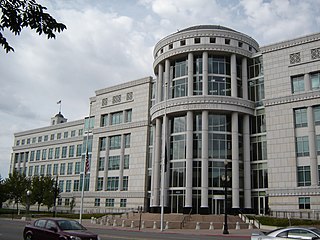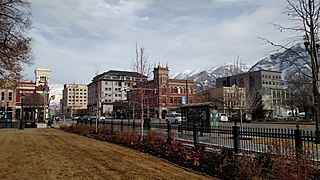
Utah is a landlocked state in the Mountain West subregion of the Western United States. It borders Colorado to its east, Wyoming to its northeast, Idaho to its north, Arizona to its south, and Nevada to its west. Utah also touches a corner of New Mexico in the southeast. Of the fifty U.S. states, Utah is the 13th-largest by area; with a population over three million, it is the 30th-most-populous and 11th-least-densely populated. Urban development is mostly concentrated in two areas: the Wasatch Front in the north-central part of the state, which is home to roughly two-thirds of the population and includes the capital city, Salt Lake City; and Washington County in the southwest, with more than 180,000 residents. Most of the western half of Utah lies in the Great Basin.

Salt Lake City, often shortened to Salt Lake or SLC, is the capital and most populous city of the U.S. state of Utah. It is the seat of Salt Lake County, the most populous county in the state. The city is the core of the Salt Lake City Metropolitan Statistical Area (MSA), which had a population of 1,257,936 at the 2020 census. Salt Lake City is further situated within a larger metropolis known as the Salt Lake City–Ogden–Provo Combined Statistical Area, a corridor of contiguous urban and suburban development stretched along a 120-mile (190 km) segment of the Wasatch Front, comprising a population of 2,746,164, making it the 22nd largest in the nation. With a population of 200,133 in 2020, it is the 117th most populous city in the United States. It is also the central core of the larger of only two major urban areas located within the Great Basin.

Salt Lake County is located in the U.S. state of Utah. As of the 2020 United States census, the population was 1,185,238, making it the most populous county in Utah. Its county seat and largest city is Salt Lake City, the state capital. The county was created in 1850. Salt Lake County is the 37th most populated county in the United States and is one of four counties in the Rocky Mountains to make it into the top 100. Salt Lake County has been the only county of the first class in Utah – under the Utah Code is a county with a population of 700,000 or greater. Although, Utah County directly to the south has recently reached this threshold.

Provo is a city in and the county seat of Utah County, Utah, United States. It is 43 miles (69 km) south of Salt Lake City along the Wasatch Front, and lies between the cities of Orem to the north and Springville to the south. With a population at the 2020 census of 115,162, Provo is the fourth-largest city in Utah and the principal city in the Provo-Orem metropolitan area, which had a population of 526,810 at the 2010 census. It is Utah's second-largest metropolitan area after Salt Lake City.

Novell, Inc. was an American software and services company headquartered in Provo, Utah, that existed from 1980 until 2014. Its most significant product was the multi-platform network operating system known as Novell NetWare.

The Wasatch Range or Wasatch Mountains is a mountain range in the western United States that runs about 160 miles (260 km) from the Utah-Idaho border south to central Utah. It is the western edge of the greater Rocky Mountains, and the eastern edge of the Great Basin region. The northern extension of the Wasatch Range, the Bear River Mountains, extends just into Idaho, constituting all of the Wasatch Range in that state.
Bottega University is a for-profit, accredited distance learning university headquartered in Salt Lake City, Utah, United States.

The Wasatch Front is a metropolitan region in the north-central part of the U.S. state of Utah. It consists of a chain of mostly contiguous cities and towns stretched along the Wasatch Range from approximately Santaquin in the south to Logan in the north, and containing the cities of Salt Lake City, Bountiful, Layton, and Ogden.
Raymond John "Ray" Noorda was a U.S. computer businessman. He was CEO of Novell between 1982 and 1994. He also served as chairman of Novell until he was replaced in 1994.

Utah Valley is a valley in North Central Utah located in Utah County, and is considered part of the Wasatch Front. It contains the cities of Provo, Orem, and their suburbs, including Alpine, American Fork, Cedar Hills, Elk Ridge, Highland, Lehi, Lindon, Mapleton, Payson, Pleasant Grove, Salem, Santaquin, Saratoga Springs, Spanish Fork, Springville, Vineyard and Woodland Hills. It is known colloquially as "Happy Valley".
Ralph J. Yarro is an American business executive, entrepreneur and an activist. He co-founded Atua Ventures and was previously the CEO of the Canopy Group. Yarro has been associated with various technology companies, including Altiris, Caldera, Techcyte and Voonami.
Suhas S. Patil is an Indian-American entrepreneur, academic, and venture capitalist. He founded Cirrus Logic, a fabless semiconductor company. Patil's work has covered computer architecture, parallel processing computers, very-large-scale integration devices, and integrated circuit design automation software. He also serves on the boards of The Tech Museum and the World Affairs Council of Northern California. He is known for describing the "cigarette smokers problem" for concurrent computing in 1971.

The Wasatch Fault is an active fault located primarily on the western edge of the Wasatch Mountains in the U.S. states of Utah and Idaho. The fault is about 240 miles long, stretching from southern Idaho, through northern Utah, before terminating in central Utah near the town of Fayette. The fault is made up of ten segments, five of which are considered active. On average the segments are approximately 25 miles long, each of which can independently produce earthquakes as powerful as local magnitude 7.5. The five active segments from north to south are called the Brigham City Fault Segment, the Weber Fault Segment, the Salt Lake City Fault Segment, the Provo Fault Segment and the Nephi Fault Segment.

Novell BrainShare was a technical computer conference sponsored by Novell during the years 1985 through 2014. It was held annually in Salt Lake City, Utah, most often in March of each year, and typically lasted for much of a week. During its early years it was held in a hotel; then for much of the 1990s the conference was held on the campus of the University of Utah; finally beginning in 1997 it was held in the Salt Palace Convention Center. During the keynote addresses for the conference, Novell would present its vision of the direction of the computer industry and how its products fit into that direction. There were then many highly technical breakout sessions where Novell technologies were explained in detail and customers and partners could engage Novell engineers regarding them. Typically some 5,000 to 7,000 attendees came to each BrainShare.

The John and Marcia Price College of Engineering at the University of Utah is an academic college of the University of Utah in Salt Lake City, Utah. The college offers undergraduate and graduate degrees in engineering and computer science.
The University of Utah Research Park, also known as Bionic Valley, is located on the campus of the University of Utah in Salt Lake City, United States. The facility has helped create many businesses based on the work of university scientists over the years. Research Park now houses more than forty companies alongside sixty-nine academic departments and employs more than 7,500 people. The annual in-state productivity of park residents exceeds $550 million.

Domo, Inc. is an American cloud software company based in American Fork, Utah, United States. It specializes in business intelligence tools and data visualization.

The Kahlert School of Computing is a school within the College of Engineering at the University of Utah in Salt Lake City, Utah.












